Microaggressions in Medicine: Gallery

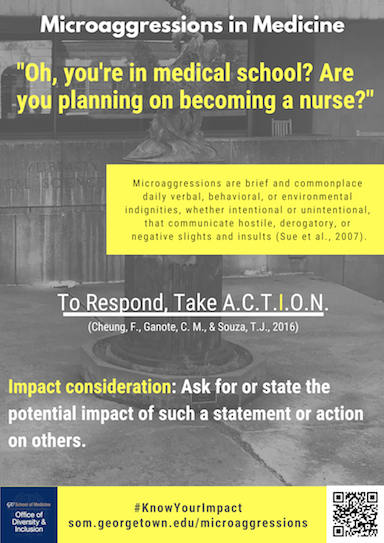
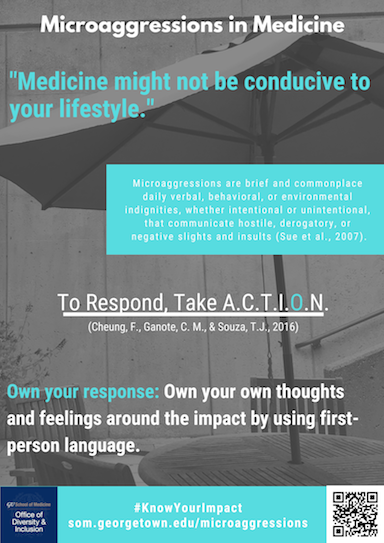
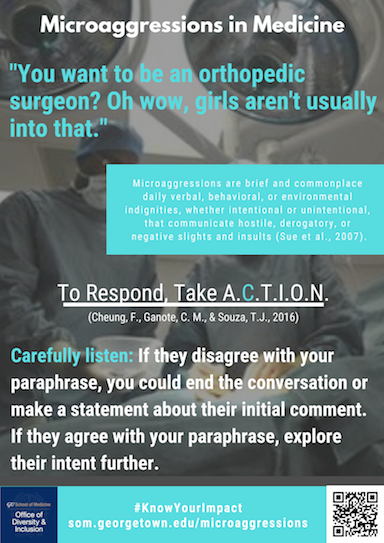
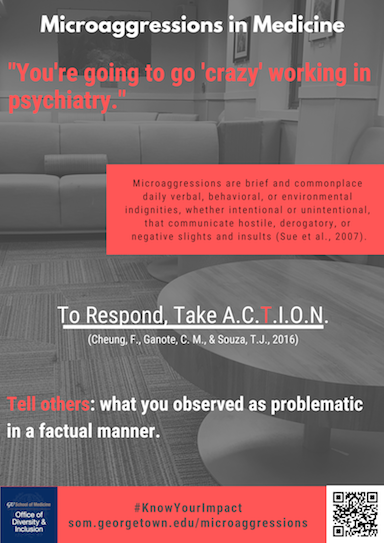
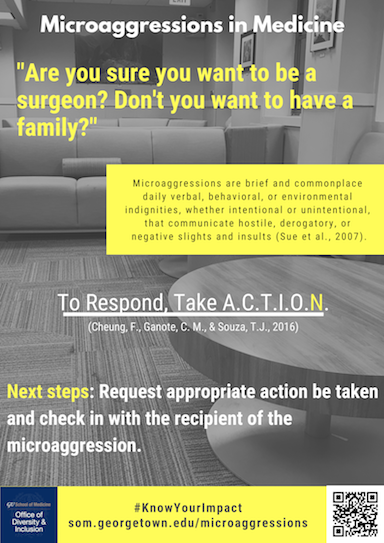
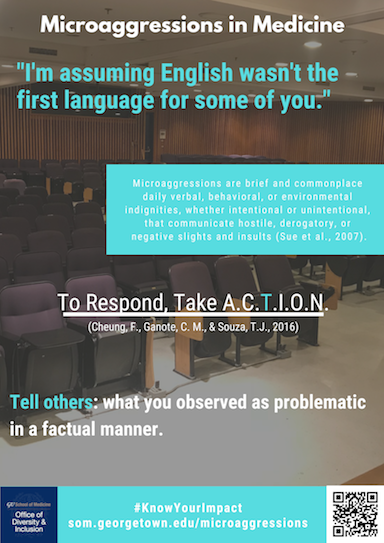
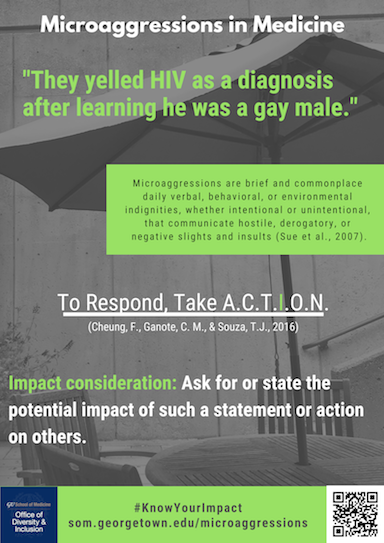
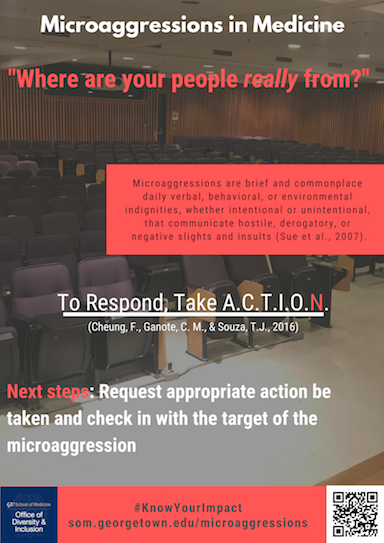








Microaggressions in Medicine Gallery: Text Version
Poster 1
Title: Microaggressions in Medicine
[Background picture of statue outside of Dahlgren Memorial Library]
“I was told not to choose to practice different specialties if I ever wanted to have children.”
[Text enclosed in a red rectangular text box]
Microaggressions are brief and commonplace daily verbal, behavioral, or environmental indignities, whether intentional or unintentional, that communicate hostile, derogatory, or negative slights and insults (Sue et al., 2007)
[Large white text, underlined]
To Respond, Take A.C.T.I.O.N.
(Cheung, F. Ganote, C.M., & Souza, T.J., 2016)
[“Carefully Listen” in red text, the rest in white]
Carefully listen: If they disagree with your paraphrase, you could end the conversation or make a statement about their initial comment. If they agree with your paraphrase, explore their intent further.
[Red banner at the bottom of the flyer. On the left is the dark blue Office of Diversity and Inclusion Logo. On the right is a QR code that links to the Microaggressions in Medicine landing page (som.georgetown.edu/microaggressions)]
Poster 2
Title: Microaggressions in Medicine
[Background picture of statue outside of Dahlgren Memorial Library]
“Oh, you’re in medical school? Are you planning on becoming a nurse?”
[Text enclosed in a yellow rectangular text box]
Microaggressions are brief and commonplace daily verbal, behavioral, or environmental indignities, whether intentional or unintentional, that communicate hostile, derogatory, or negative slights and insults (Sue et al., 2007)
[Large white text, underlined]
To Respond, Take A.C.T.I.O.N.
(Cheung, F. Ganote, C.M., & Souza, T.J., 2016)
[“Impact consideration” in yellow text, the rest in white]
Impact Consideration: Ask for or state the potential impact of such a statement or action on others.
[Yellow banner at the bottom of the flyer. On the left is the dark blue Office of Diversity and Inclusion Logo. On the right is a QR code that links to the Microaggressions in Medicine landing page (som.georgetown.edu/microaggressions)]
Poster 3
Title: Microaggressions in Medicine
[Background picture of picnic table with umbrella outside of Dahlgren Memorial Library]
“Medicine might not be conducive to your lifestyle.”
[Text enclosed in a blue rectangular text box]
Microaggressions are brief and commonplace daily verbal, behavioral, or environmental indignities, whether intentional or unintentional, that communicate hostile, derogatory, or negative slights and insults (Sue et al., 2007)
[Large white text, underlined]
To Respond, Take A.C.T.I.O.N.
(Cheung, F. Ganote, C.M., & Souza, T.J., 2016)
[“Own your response” in blue text, the rest in white]
Own your response: Own your own thoughts and feelings around the impact by using first-person language.
[Blue banner at the bottom of the flyer. On the left is the dark blue Office of Diversity and Inclusion Logo. On the right is a QR code that links to the Microaggressions in Medicine landing page (som.georgetown.edu/microaggressions)]
Poster 4
Title: Microaggressions in Medicine
[Background picture of surgeons at work with lights overhead]
“You want to be an orthopedic surgeon? Wow, girls aren’t usually into that.”
[Text enclosed in a blue rectangular text box]
Microaggressions are brief and commonplace daily verbal, behavioral, or environmental indignities, whether intentional or unintentional, that communicate hostile, derogatory, or negative slights and insults (Sue et al., 2007)
[Large white text, underlined]
To Respond, Take A.C.T.I.O.N.
(Cheung, F. Ganote, C.M., & Souza, T.J., 2016)
[“Carefully Listen” in blue text, the rest in white]
Carefully listen: If they disagree with your paraphrase, you could end the conversation or make a statement about their initial comment. If they agree with your paraphrase, explore their intent further.
[Blue banner at the bottom of the flyer. On the left is the dark blue Office of Diversity and Inclusion Logo. On the right is a QR code that links to the Microaggressions in Medicine landing page (som.georgetown.edu/microaggressions)]
Poster 5
Title: Microaggressions in Medicine
[Background picture of couches and tables in the Caduceus student lounge]
“You’re going to go ‘crazy’ working in psychiatry.”
[Text enclosed in a red rectangular text box]
Microaggressions are brief and commonplace daily verbal, behavioral, or environmental indignities, whether intentional or unintentional, that communicate hostile, derogatory, or negative slights and insults (Sue et al., 2007)
[Large white text, underlined]
To Respond, Take A.C.T.I.O.N.
(Cheung, F. Ganote, C.M., & Souza, T.J., 2016)
[“Tell others” in red text, the rest in white]
Tell others: what you observed as problematic in a factual manner.
[Red banner at the bottom of the flyer. On the left is the dark blue Office of Diversity and Inclusion Logo. On the right is a QR code that links to the Microaggressions in Medicine landing page (som.georgetown.edu/microaggressions)]
Poster 6
Title: Microaggressions in Medicine
[Background picture of couches and tables in the Caduceus student lounge]
“Are you sure you want to be a surgeon? Don’t you want to have a family?”
[Text enclosed in a yellow rectangular text box]
Microaggressions are brief and commonplace daily verbal, behavioral, or environmental indignities, whether intentional or unintentional, that communicate hostile, derogatory, or negative slights and insults (Sue et al., 2007)
[Large white text, underlined]
To Respond, Take A.C.T.I.O.N.
(Cheung, F. Ganote, C.M., & Souza, T.J., 2016)
[“Tell others” in yellow text, the rest in white]
Tell others: what you observed as problematic in a factual manner.
[Yellow banner at the bottom of the flyer. On the left is the dark blue Office of Diversity and Inclusion Logo. On the right is a QR code that links to the Microaggressions in Medicine landing page (som.georgetown.edu/microaggressions)]
Poster 7
Title: Microaggressions in Medicine
[Background picture of seats in Medical Dental Building GA 2/4 Auditorium]
“I’m assuming English wasn’t the first language for some of you.”
[Text enclosed in a blue rectangular text box]
Microaggressions are brief and commonplace daily verbal, behavioral, or environmental indignities, whether intentional or unintentional, that communicate hostile, derogatory, or negative slights and insults (Sue et al., 2007)
[Large white text, underlined]
To Respond, Take A.C.T.I.O.N.
(Cheung, F. Ganote, C.M., & Souza, T.J., 2016)
[“Tell others” in blue text, the rest in white]
Tell others: what you observed as problematic in a factual manner.
[Blue banner at the bottom of the flyer. On the left is the dark blue Office of Diversity and Inclusion Logo. On the right is a QR code that links to the Microaggressions in Medicine landing page (som.georgetown.edu/microaggressions)]
Poster 8
Title: Microaggressions in Medicine
[Background picture of picnic table with umbrella outside of Dahlgren Memorial Library]
“They yelled HIV as a diagnosis after learning he was a gay male.”
[Text enclosed in a green rectangular text box]
Microaggressions are brief and commonplace daily verbal, behavioral, or environmental indignities, whether intentional or unintentional, that communicate hostile, derogatory, or negative slights and insults (Sue et al., 2007)
[Large white text, underlined]
To Respond, Take A.C.T.I.O.N.
(Cheung, F. Ganote, C.M., & Souza, T.J., 2016)
[“Impact consideration” in green text, the rest in white]
Impact Consideration: Ask for or state the potential impact of such a statement or action on others.
[Green banner at the bottom of the flyer. On the left is the dark blue Office of Diversity and Inclusion Logo. On the right is a QR code that links to the Microaggressions in Medicine landing page (som.georgetown.edu/microaggressions)]
Poster 9
Title: Microaggressions in Medicine
[Background picture of seats in Medical Dental Building GA 2/4 Auditorium]
“Where are your people really from?”
[Text enclosed in a red rectangular text box]
Microaggressions are brief and commonplace daily verbal, behavioral, or environmental indignities, whether intentional or unintentional, that communicate hostile, derogatory, or negative slights and insults (Sue et al., 2007)
[Large white text, underlined]
To Respond, Take A.C.T.I.O.N.
(Cheung, F. Ganote, C.M., & Souza, T.J., 2016)
[“Next steps” in red text, the rest in white]
Next steps: Request appropriate action be taken and check in with the target of the microaggression.
[Red banner at the bottom of the flyer. On the left is the dark blue Office of Diversity and Inclusion Logo. On the right is a QR code that links to the Microaggressions in Medicine landing page (som.georgetown.edu/microaggressions)]
Poster 10
Title: Microaggressions in Medicine
[Background picture of hallway in Medical Dental building leading to Proctor Harvey]
“You speak English well.”
[Text enclosed in a green rectangular text box]
Microaggressions are brief and commonplace daily verbal, behavioral, or environmental indignities, whether intentional or unintentional, that communicate hostile, derogatory, or negative slights and insults (Sue et al., 2007)
[Large white text, underlined]
To Respond, Take A.C.T.I.O.N.
(Cheung, F. Ganote, C.M., & Souza, T.J., 2016)
[“Own your response” in green text, the rest in white]
Own your response: Own your own thoughts and feelings around the impact by using first-person language.
[Red banner at the bottom of the flyer. On the left is the dark blue Office of Diversity and Inclusion Logo. On the right is a QR code that links to the Microaggressions in Medicine landing page (som.georgetown.edu/microaggressions)]
Poster 11
Title: Microaggressions in Medicine
[Background picture of hallway in Medical Dental building leading to Proctor Harvey]
“This might be too long of a road for you.”
[Text enclosed in a blue rectangular text box]
Microaggressions are brief and commonplace daily verbal, behavioral, or environmental indignities, whether intentional or unintentional, that communicate hostile, derogatory, or negative slights and insults (Sue et al., 2007)
[Large white text, underlined]
To Respond, Take A.C.T.I.O.N.
(Cheung, F. Ganote, C.M., & Souza, T.J., 2016)
[“Next steps” in blue text, the rest in white]
Next steps: Request appropriate action be taken and check in with the target of the microaggression.
[Blue banner at the bottom of the flyer. On the left is the dark blue Office of Diversity and Inclusion Logo. On the right is a QR code that links to the Microaggressions in Medicine landing page (som.georgetown.edu/microaggressions)]
Poster 12
Title: Microaggressions in Medicine
[Background picture of seats in Medical Dental Building GA 2/4 Auditorium]
“All of our professors have accents”
[Text enclosed in a green rectangular text box]
Microaggressions are brief and commonplace daily verbal, behavioral, or environmental indignities, whether intentional or unintentional, that communicate hostile, derogatory, or negative slights and insults (Sue et al., 2007)
[Large white text, underlined]
To Respond, Take A.C.T.I.O.N.
(Cheung, F. Ganote, C.M., & Souza, T.J., 2016)
[“Ask” in green text, the rest in white]
Ask: clarifying questions to assist with understanding the person’s intentions.
[Green banner at the bottom of the flyer. On the left is the dark blue Office of Diversity and Inclusion logo. On the right is a QR code that links to the Microaggressions in Medicine landing page (som.georgetown.edu/microaggressions)]
Poster 13
Title: Microaggressions in Medicine
[Background picture of surgeons at work with lights overhead]
“How can you be be a surgeon if you can’t even reach over the table?”
[Text enclosed in a yellow rectangular text box]
Microaggressions are brief and commonplace daily verbal, behavioral, or environmental indignities, whether intentional or unintentional, that communicate hostile, derogatory, or negative slights and insults (Sue et al., 2007)
[Large white text, underlined]
To Respond, Take A.C.T.I.O.N.
(Cheung, F. Ganote, C.M., & Souza, T.J., 2016)
[“Tell others” in yellow text, the rest in white]
Tell others: what you observed as problematic in a factual manner.
[Yellow banner at the bottom of the flyer. On the left is the dark blue Office of Diversity and Inclusion logo. On the right is a QR code that links to the Microaggressions in Medicine landing page (som.georgetown.edu/microaggressions)]
Poster 14
Title: Microaggressions in Medicine
[Background picture of basement hallway in Medical Dental Building with a portrait of Jack the Bulldog on the wall]
“Aren’t you a little old to be in medical school?”
[Text enclosed in a blue rectangular text box]
Microaggressions are brief and commonplace daily verbal, behavioral, or environmental indignities, whether intentional or unintentional, that communicate hostile, derogatory, or negative slights and insults (Sue et al., 2007)
[Large white text, underlined]
To Respond, Take A.C.T.I.O.N.
(Cheung, F. Ganote, C.M., & Souza, T.J., 2016)
[“Carefully listen” in blue text, the rest in white]
Carefully listen: If they disagree with your paraphrase, you could end the conversation or make a statement about their initial comment. If they agree with your paraphrase, explore their intent further.
[Blue banner at the bottom of the flyer. On the left is the dark blue Office of Diversity and Inclusion logo. On the right is a QR code that links to the Microaggressions in Medicine landing page (som.georgetown.edu/microaggressions)]
Poster 15
Title: Microaggressions in Medicine
[Background picture is an aerial picture of Proctor Harvey Amphitheater]
“Being referred to as ‘the other one.’ I have been on the same service 2 weeks and attending has not asked what my name is.”
[Text enclosed in a red rectangular text box]
Microaggressions are brief and commonplace daily verbal, behavioral, or environmental indignities, whether intentional or unintentional, that communicate hostile, derogatory, or negative slights and insults (Sue et al., 2007)
[Large white text, underlined]
To Respond, Take A.C.T.I.O.N.
(Cheung, F. Ganote, C.M., & Souza, T.J., 2016)
[“Ask” in red text, the rest in white]
Ask: clarifying questions to assist with understanding the person’s intentions.
[Red banner at the bottom of the flyer. On the left is the dark blue Office of Diversity and Inclusion logo. On the right is a QR code that links to the Microaggressions in Medicine landing page (som.georgetown.edu/microaggressions)]
Poster 16
Title: Microaggressions in Medicine
[Background is an aerial picture of Proctor Harvey Amphitheater]
“Medicine’s path is too long and expensive and hard of a road for someone with your background.”
[Text enclosed in a yellow rectangular text box]
Microaggressions are brief and commonplace daily verbal, behavioral, or environmental indignities, whether intentional or unintentional, that communicate hostile, derogatory, or negative slights and insults (Sue et al., 2007)
[Large white text, underlined]
To Respond, Take A.C.T.I.O.N.
(Cheung, F. Ganote, C.M., & Souza, T.J., 2016)
[“Ask” in yellow text, the rest in white]
Ask: clarifying questions to assist with understanding the person’s intentions.
[Yellow banner at the bottom of the flyer. On the left is the dark blue Office of Diversity and Inclusion logo. On the right is a QR code that links to the Microaggressions in Medicine landing page (som.georgetown.edu/microaggressions)]
Poster 17
Title: Microaggressions in Medicine
[Background picture is an aerial picture of Proctor Harvey Amphitheater]
“Oh, you’re a parent and in medical school? What were you thinking?”
[Text enclosed in a green rectangular text box]
Microaggressions are brief and commonplace daily verbal, behavioral, or environmental indignities, whether intentional or unintentional, that communicate hostile, derogatory, or negative slights and insults (Sue et al., 2007)
[Large white text, underlined]
To Respond, Take A.C.T.I.O.N.
(Cheung, F. Ganote, C.M., & Souza, T.J., 2016)
[“Own your response” in green text, the rest in white]
Own your response: Own your own thoughts and feelings around the impact by using first-person language.
[Green banner at the bottom of the flyer. On the left is the dark blue Office of Diversity and Inclusion logo. On the right is a QR code that links to the Microaggressions in Medicine landing page (som.georgetown.edu/microaggressions)]
